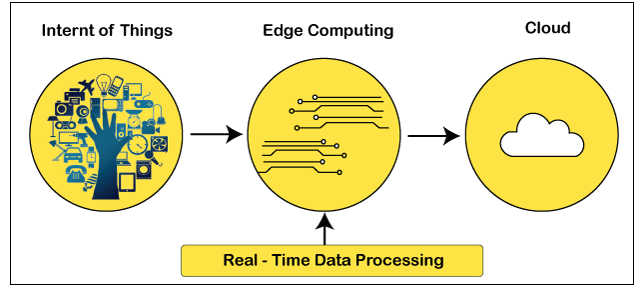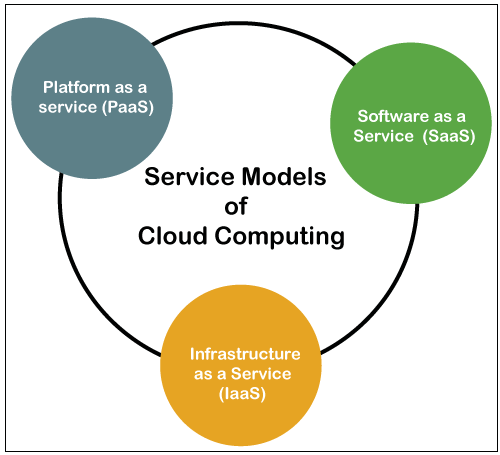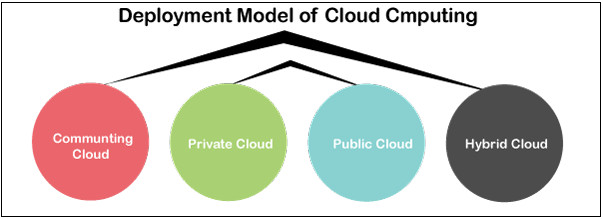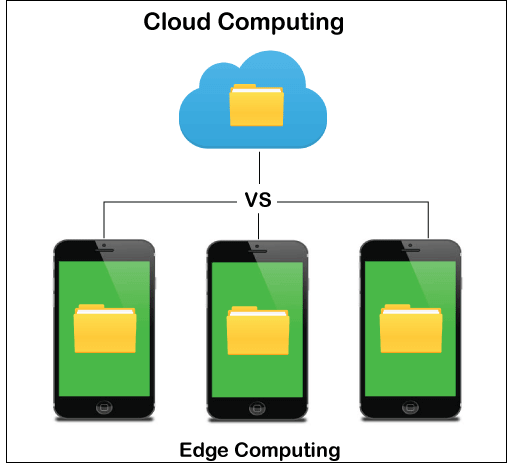Difference Between Edge Computing and Cloud ComputingAs a distributed environment, the concept "Edge computing" applies to computing. It carries storage and computational power nearer to the computer where it is really essential for the information sources. On the cloud, routed via dispersed data centers, data is not scanned; rather the cloud comes to everyone. Lag-time is reduced by this allocation and storage is saved. In comparison to the "IOT technology," Edge Computing is an alternative method to the computing world. It is about accessing real-time data close to the data source, which is called the channel's "edge." Rather than a consolidated cloud or database server or data storage venue, it is about virtual machines as physically near as practicable to the place where the data is produced. For example- When a vehicle measures fuel utilization automatically, sensors dependent on data explicitly obtained from the sensors, the machine executing the operation is referred to as an Edge computing system or literally 'edge device.' Because of this shift in data procurement and management, we will evaluate the two techniques and discuss the advantages each has to provide. A snag-all concept for applications that capture some of their main processes and transfer them to the network layer (near the device) is the concept of edge computing. Computer technology and database, and networking involve these mechanisms. What is Edge ComputingEdge Computing enables the deployment of computing resources and communication technologies through a unified computing infrastructure along with the transmission channel. By using edge computing, computational requirements are more easily fulfilled. Wherever there is an information gathering necessity or where a user performs a specific activity, it can be performed in real-time. Usually, increased efficiency and decreased operational costs are the two primary advantages connected with edge computing, that are defined below. 
Advantages of Edge ComputingSome advantages of Edge computing are discussed below- 1. Security While the emergence of IoT edge computing devices increases the networks' total attack vectors, it also offers some major safety benefits. The conventional cloud computing architecture is fundamentally centralized, which makes it extremely vulnerable to exploitation and power failures from decentralized denial of service (DDoS). Edge computing disburses computation, storage, and apps through a broad variety of devices and cloud services, making it impossible to take down the service for any single disturbance. 2. Speed Edge computing's most significant advantage is the potential to improve network productivity by minimizing the latency. The data they accumulate does not have to move almost as far as it would under such a conventional cloud environment, since IoT edge computing devices manage private data or in neighboring edge data centers. Speed is completely essential to the business model for many businesses. For example, the dependence of the finance industry on high-frequency trading algorithms means that a slowing of simple milliseconds can have serious impacts. Abandoning a couple of seconds in the healthcare industry may also be a life or death issue. And for companies that provide consumers with data-driven utilities, sluggish speeds can annoy consumers and cause of the long-term harm for a brand. 3. Performance Improvement Edge computing also collects, analyzes, and conducts appropriate actions on the gathered data locally, in addition to collecting data for transfer to the cloud. Although these activities have been completed in milliseconds, no matter what all the operations might be, it is becoming important to optimize technical information. It can be an obstacle to transmit large volumes of data in real-time in a cost-effective manner, specifically when carried out from isolated industrial plants. By attaching intelligence to tools available at the network edge, this issue is resolved. Edge computing takes analytics tools closer to the computer, which eliminates the middle-man out. This configuration offers less costly options for maximizing the efficiency of properties. 4. Reducing Operational Costs Communication, data management, throughput, and performance features are surprisingly costly in the cloud computing model. Edge computing, which has a substantially lower bandwidth demand and less bandwidth, remedies this inefficiency. A useful continuum from the computer to the cloud is produced through the implementation of edge computing, that can accommodate the vast amounts of data collected. Expensive bandwidth improvements are no longer needed, because gigabytes of data need not be transferred to the cloud. Edge computing may actually reduce cloud reliance and, as a response, increase the speed of data analysis. In addition, there are also several modern IoT tools that have sufficient processing power and storage. The transition to edge computing power enables these devices to be used to their maximum capabilities. 5. Scalability The companies can't always predict their IT infrastructure requirements as businesses expand, and constructing a specialized private cloud is an unnecessary expense. There is also the problem of tomorrow 's requirements, in contrast to the considerable up-front building costs and ongoing maintenance. Conventional private facilities impose an artificial restriction on growth, locking businesses into predictions of their future computing requirements. 6. Reliability Related to security benefits gained by edge computing, this should not shock that it provides better performance. Through IoT edge computing systems and cloud network infrastructure located directly to end-users, there is less risk of a network issue in a faraway place impacting local customers. Even in the case of a local data center failure, since they perform critical processing capabilities wirelessly, IoT edge computing systems can continue to work efficiently on their own. With several network-connected edge computing devices and edge network infrastructure, any failure to completely closed down service becomes even more challenging. To help the customers maintain access to the resources and information they need, information can be redirected across multiple pathways. Consequently, it can offer unparalleled durability to adopted unanimously IoT edge computing devices and edge data centers into a detailed edge architecture. 7. Versatility Edge computing's interoperability also makes it extremely flexible. Businesses can quickly reach competitive markets without continuing to spend in costly infrastructure investment by collaborating with local edge data centers. Edge data centers enable everyone, with little physical constraints or delay, to serve end-users effectively. For content producers aiming to offer unlimited subscription services, this is extremely valuable. Edge computing also makes it possible for IoT systems to collect an important amount of relevant insights. Edge computing devices are always running, always linked, and always producing data for future evaluation instead of waiting for people to log into devices and communicate with hierarchical data centers. Instances of Edge ComputingThe best way to explain the use of Edge computing strategy is through some instances of edge computing. Here are some circumstances in which the most efficient is edge computing. They are:
Some service providers such as Netflix, Hulu, Amazon Prime, and the forthcoming Disney+ all generate a high network infrastructure load. Through edge storage, Edge computing creates a great smoother experience. This is when common data for simpler and faster connectivity is preserved in facilities closer to end-users.
In order to operate appropriately in real-time, self-driven or Artificial Intelligence-powered cars and other vehicles need a huge amount of data from their environment. If cloud storage is being used, a slowdown will arise.
The increasing proliferation of smart homes presents a challenge, equivalent to streaming services. In order to focus on traditional cloud computing only, it is now much more of network congestion. Processing of data is closer to the source ensures lower delay in case of an emergency and faster response times. Medical teams, fire, or the deployment of police are some examples. If the cloud is placed in different locations around the world, companies can lose control of their data. For some institutions, such as banks, which are allowed by law to process information in their native country only, this configuration may present a problem. Even though attempts are being made to find a solution cloud computing has obvious drawbacks, when it refers to cloud data protection. What is Cloud computingCloud computing is defined as the use of different resources via Internet access, such as application development frameworks, storage, servers, as well as other software. Cloud service providers have three common features that are described below:
Cloud computing Service Models
In terms of market structures, cloud computing systems can be implemented, which may vary based on particular requirements. Some of the traditional application services used are briefly listed below. They are- 1. Platform as a service (PaaS) PaaS enables consumers to browse platform access, enabling them to implement the software and cloud implementations. Operating systems or internet connectivity are not controlled by the user, which can impose some limitations on the software's scope that can be implemented. Instances include Amazon Web Services, Rackspace, and Microsoft Azure. 2. Software as a service (SaaS) In SaaS, the right to access or use of a cloud-hosted program or service must be purchased by customers. 3. Infrastructure as a service (IaaS) In IaaS, customers can monitor and handle the operating systems, software, network access, and storage without managing the cloud itself. Cloud computing Deployment Models
Cloud computing virtualization technologies also rely on prerequisites, just the same as the deployment model. There are four main types of models, each having its own features. 1. Community cloud Cloud-based infrastructure and services enable multiple companies with similar goals and similar requirements to access a cloud. As an outcome, it is spread by the various organizations using it; this reduces capital spending expenditures. These activities may be implemented on-site with a third party. 2. Private Cloud For particular organizations only, private clouds are deployed, managed, and controlled. 3. Public Cloud Public clouds will be used on a subscription basis by the people but are operated by a company of cloud service. Consequently, without the considerable economic resources needed for other deployment options, a customer can build and implement a service. 4. Hybrid cloud Numerous kinds of clouds comprise of this sort of cloud services. However such cloud has the ability to enable data and apps to migrate from one domain to the next. Hybrid clouds may also be a mixture of public and private clouds. Advantages of Cloud computingAmong the several challenges raised by cloud computing, some advantages of cloud computing are defined below- 1. Flexibility Cloud Computing enables businesses to operate with a small cloud implementation and grow very quickly and effectively. When the situation requires it, scaled back can also be achieved soon. It also allows businesses, when appropriate, to add additional resources that help to reach increasing consumer demands. 2. Consistency System security and recovery procedures are supported by service providers using various inefficient webpages. 3. Save expenditure Once it comes to enhancing the computational capabilities, enterprises can dramatically reduce their capital and operational spending through cloud computing. 4. Mobile Accessibility Mobile connectivity is also supported to a greater degree by cloud computing. 5. Maintenance The cloud computing providers often perform maintenance activities. Difference between Edge Computing and Cloud ComputingRemember that it is not advisable for the advent of edge computing to be a complete substitution for cloud computing. For instance, their distinctions can be compared to those between that SUV and a sports car. There are various functions and uses of both vehicles. Here, we built a table of contrasts to help understand the discrepancy. 
Next TopicDifference between
|
 For Videos Join Our Youtube Channel: Join Now
For Videos Join Our Youtube Channel: Join Now
Feedback
- Send your Feedback to [email protected]
Help Others, Please Share










